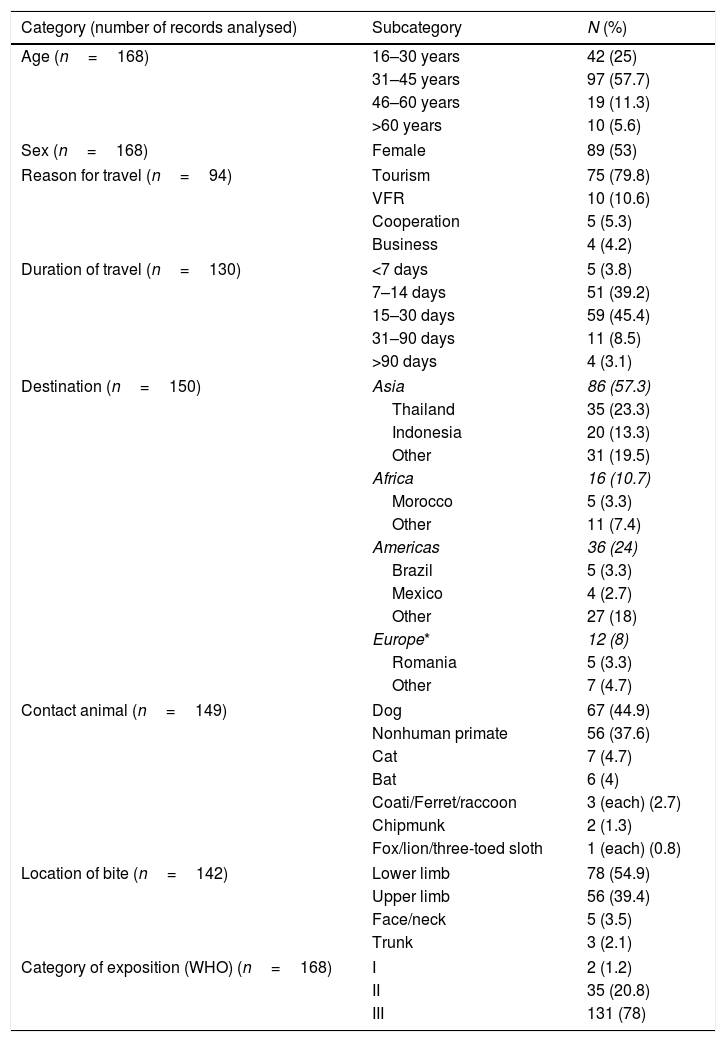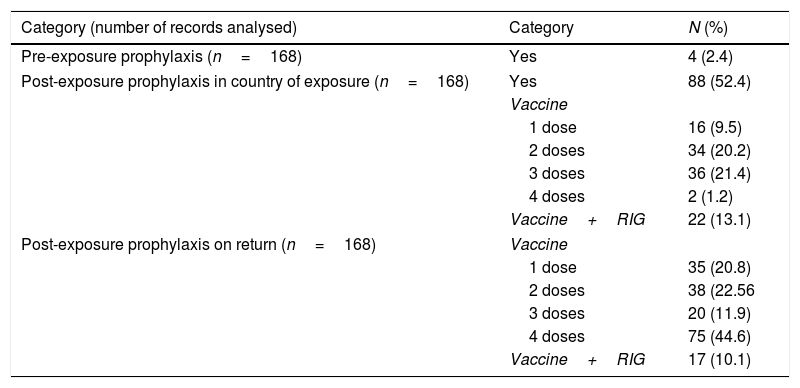Rabies represents a major public health issue for travellers because pretravel preexposure (PrEP) rabies vaccination is not routinely indicated. For those unvaccinated, adequate postexposure prophylaxis (PEP), including rabies immunoglobulin (RIG) if needed, is the only effective method to prevent this fatal disease.
MethodsDescriptive retrospective study at a National Referral Unit for Tropical and Travel Medicine in Madrid, Spain, among travellers treated with PEP for rabies (January 2012–December 2017). Demographic, clinical and management data were reviewed.
Results168 patients were treated for possible rabies exposure (53% females, median age 35 years; IQR: 31–42). Southeast Asia accounted for more than half of the cases (N=86, 57.3%; CI 95% 49–65%). Dogs were the primary animal involved (n=67, 44.9%; CI 37–53%). After the bite, in half of the cases (n=88, 52.4%; CI 44–60%) PEP rabies vaccine was started abroad, and the vaccine plus RIG in about 10% (n=22, 13.1%; CI: 8–19%). Most of patients classified as category III did not received RIG at all (n=88, 69.3% CI: 60–77%).
ConclusionsAlthough indicated, most travellers did not receive RIG abroad, nor appropriate first doses of PEP. Clinicians should be aware of the importance of appropriate PrEP in selected individuals.
La rabia representa un importante problema de salud pública para los viajeros, porque la profilaxis pre-exposición (PrEP, por sus siglas en inglés) —vacuna contra la rabia— no está indicada de manera rutinaria. Para aquellos que no están vacunados, una adecuada profilaxis postexposición (PEP), que incluya, si fuera necesario, la inmunoglobulina antirrábica (RIG), es el único método eficaz para prevenir esta enfermedad mortal.
MétodosEstudio descriptivo retrospectivo en una Unidad de Referencia Nacional para Medicina Tropical y Salud Internacional en Madrid, España, con los viajeros atendidos para tratamiento de rabia con PEP (enero de 2012 a diciembre de 2017). Se revisaron los datos demográficos, clínicos y de gestión.
ResultadosCiento sesenta y ocho pacientes fueron tratados por una posible exposición a la rabia (53% mujeres; edad media: 35 años; RIC: 31-42). La región del sudeste asiático representó más de la mitad de los casos (n=86, 57,3%; IC 95%: 49-65%). Los perros fueron los animales más involucrados en la exposición (n=67, 44,9%; IC 95%: 37-53%). Después de que el paciente fue mordido, la PEP contra la rabia se inició en el extranjero en la mitad de los casos (n=88, 52,4%; IC 95%: 44-60%) y la vacuna más la RIG en aproximadamente el 10% (n=22, 13,1%; IC 95%: 8-19%). La mayoría de los pacientes clasificados en la categoría III no recibieron RIG en absoluto (n=88, 69,3%; IC 95%: 60-77%).
ConclusionesAunque es indicado, la mayoría de los viajeros no recibieron ni la RIG en el extranjero, ni las primeras dosis apropiadas de PEP. Los profesionales de salud deben ser conscientes de la importancia de una PrEP apropiada en individuos seleccionados.








